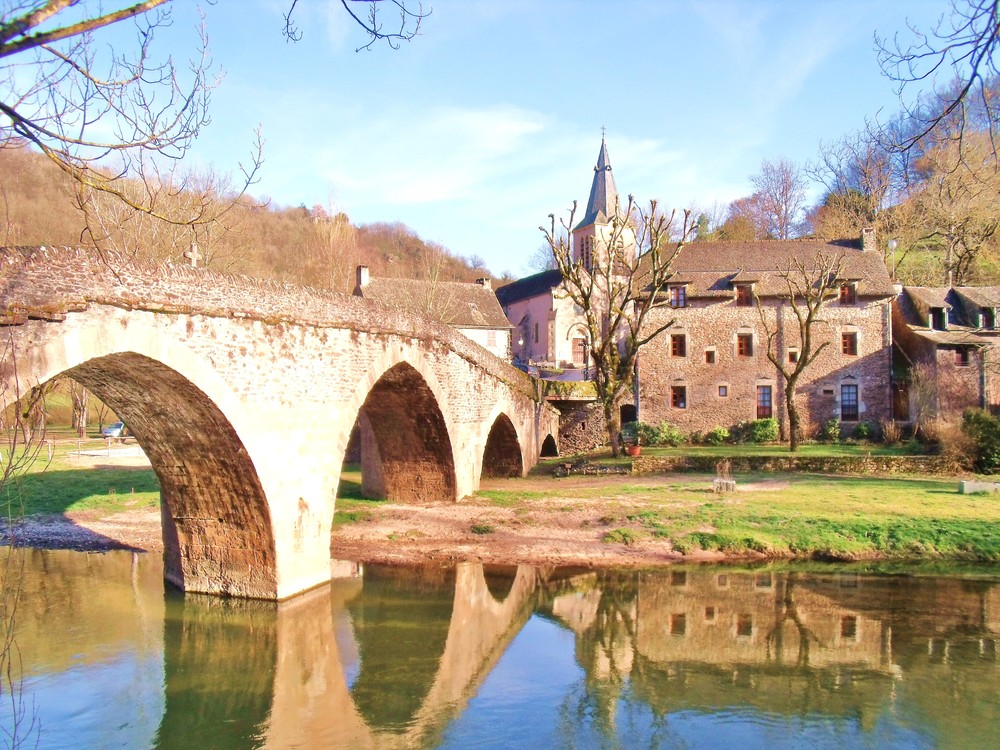Belcastel, South West France and Château de Belcastel seems from the majority of our guests this year to be the most loved place to visit while staying at Le Château De La Rivière. Why is that we ask?
Well you only have to visit and you will know why, but here we will try and let you all know just what makes Belcastel so beautiful.
You can look at Wiki data and Google pictures and you will have information overload about Belcastel and it’s surrounding lanscapes, but when you actually drive around that corner and you see the hillside built village for the first time you will go WOW….. That image will stay with you for many many years.
Is it the way the skinny cobbled streets wind their way up the hillside to the focus point of the village, Château de Belcastel, the fully renovated castle? Or is it the ancient arched bridge spanning the Aveyron that splits the village in two, but makes for a stunning panorama? Or maybe it is just the wonderful quaintness of its buildings and how they all intermingle in a typically ‘bastide’ way? Whatever it is will be different for everyone who visits, but it will leave an impression on you.
A quick history lesson on Château de Belcastel.
Château de Belcastel started out as one of the castles along the route of the Lords of Rouergue. It started as a chapel in 9th century. In the 11th century it was expanded into a fortress, was refurbished in the 15th century and promoted to a Château. Left to fall into ruin by the 19th century, then finally resurrected into its current beauty in the 20th century.
The renovation was carried out by the somewhat controversial French architect Fernand Pouillion, who rebuilt the Château stone by stone during the 1970’s. The quality of his work inspired the local villagers to match his enthusiasm and they improved their own houses to match the finish and attention to detail that Fernand wanted. Hence the whole village is now in keeping with its traditional past, but is very much in the 21st century.
 Why was Fernand a controversial figure?
Why was Fernand a controversial figure?
He produced modern architecture focussing on cultural, educational and residential projects, but also worked on two restoration projects. He built mostly in the Aix-en-Provence, Marseille and Paris , Alger (in Algeria) and Tehran (in Iran).
He is best known for his designs of, often low-cost, housing complexes in the 1950s and 1960s, including the La Tourette complex in Marseille, built 1948-1953, the new town Diar el Mahçoul in Algeria and for hotel designs in Alger between 1964-1984. He also worked on reconstruction of the war-damaged Old Port of Marseille together with Auguste Perret and others. So the controversy is that in 1961, he was jailed for his role as a building contractor on a housing project in Paris, escaped from jail, was eventually acquitted for the original crime, but jailed again for escaping. He was finally released from jail in 1964 and moved to Algeria, only to return to France in 1972, after being pardoned by the French President Georges Pompidou. It was to Belcastel he settled. He died in Belcastel on July 24th 1986 at the age of 74, where he is buried in the Chapel at Belcastel in an unmarked grave, as was his request.
Château de Belcastel is now owned by American gallery owners Heidi Leigh and Nicholas Leone, who have opened the Château to the public and hold many art galleries tastfully entwined within the restored buildings. They even have a private suite in the SE Tower with private balcony and swimming pool, ideal for newlyweds.
All around Belcastel you will find nuggets of history and intrigue, that is if you stop just admiring it’s absolute beauty.
Then take it all in while you rest at one of 4 restaurants that Belcastel offers. From 1* Michelin to a friendly lunchtime snack, you will always find it friendly and welcoming.
So come and stay with us at Le Château De La Rivière and make a day out to visit Belcastel.



